
Sense's Reminiscences
by Sense de Jong
- Geurt
- Tante Betje (by Sense)
- Tante Betje (by Truus)
- Miss Roozendaal
- Concert in Winschoten
- A baptism remembered
- My birdhouse
- War veterans
- Henk Smit - bass/baritone
- Stefan
- In memory of Herman - I
- In memory of Herman -II
- Remembering AK
- Our love for music
- Herman - Promoter of Christian Causes
- A Salem evening with Herman de Jong
- From Elsinore to Monschau
- A Danish Treat
- Glimpses of Thuringia and Saxony
- Domie and Hansie
- La Manche, Newfoundland
- Bermuda - Isle in the Sun
- 1932 and 1934
- 1940 - 1945
- Winschoten, Grace on the Venne
- 1948
- Johann Sebastian Bach
- From Generation to Generation
- Seven children and a harmonium
- K.P. - A Man of Enterprise
- Cuba and the tragedy of the MS St Louis
- It all began in Norwich, Ontario
Another site by Sense de Jong:
~ Hinne de Jong ~
A Chronicle
Sites by Henry de Jong:
~ Herman de Jong ~
Memorial
~ Newmaker Notes~
Writings, Pictures, Collections
~ AACS/ICS Niagara Conferences~
1970 - 1991
We stood in the court yard of Kronborg Slot (Castle) in the town of Helsingor, located in the NE part of Sjaelland, the largest island in Denmark. (Helsingor was immortalized as Elsinore in Shakespeare's Hamlet.)
The castle stands at the shore of the "Oresund" (Sound) which leads to the "Kattegat," gateway to the North Sea. Across the water we saw the coast of Sweden. Karin, one of the co-passengers on our tour bus, had made a vow that she would dip her toes in the water once she would get here. She said this was in honour of her forebears who came from Sweden.
It is the summer of 1994. We - members of the "Cantata Singers," a choir from St. Catharines, Ont. - tested the acoustics of the square inside the castle. And soon we spontaneously burst forth in song. We memorized nearly all of our concert pieces. As always, a crowd gathered urging us on with applause.
We'd done this before while on a concert tour in Holland and Denmark. It happened in the chapel of the nearby Fredensborg Slot, home of the Royal Danish family (the family was not there). In Holland, it happened in Leiden's "Pieterskerk" and in Vollenhove's "St. Nicolaaskerk." Unforgettable moments....
Europe, in the summer, seems to be full of tour buses. Our bus took us from the windmill "De Valk" in Leiden, the Netherlands, across the border into Germany and onto the big autobahn going north to places like Osnabrueck, Bremen, Hamburg and the harbour of Puttgarden. There we boarded the ferry to Denmark. Our destination was Hvidovre, a suburb of Copenhagen. A group of Danish friends had invited us to come to the Copenhagen area to sing several concerts.
In Hvidovre our hosts assigned us our billets. Corrie and I met our gracious hosts, Inger and Holger (an engineer) Clausen, who took us to their home in Kastrup on the island of Amager with its colourful, historic villages like Dragor and St. Magleby. The airport is nearby.
At the Kronborg Castle we just couldn't believe the large number of tour buses parked there. Our driver found a narrow space and we marvelled how skilfully he backed up into that area.
OAD Travel
There are many, many different tour bus companies in Europe and they hail from nearly every part of the continent. They crisscross the European continent, from northern Norway to the Mediterranean, from Portugal to Mongolia. They're everywhere. Obviously it is a very lucrative business!
In 2005, Corrie and I booked a trip to Germany with "OAD Reizen" (OAD Travel). For those interested, OAD is an acronym for "Overijsselse Auto Dienst." It's head office is in Holten, Overijssel, the Netherlands, which is known to many because of the large war cemetery there.
OAD's famous yellow buses carry a slogan: "Je ziet ons ook overal!" (See? You see us everywhere!), and they are literally all over Europe. Near the village of Beek, east of Arnhem, is OAD's large depot/restaurant where all buses depart from and return to.
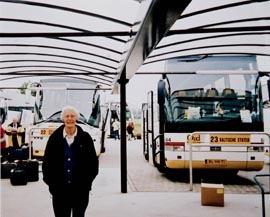
The people who have booked a trip are picked up, on the day of departure, near their homes in the Netherlands and transported to Beek. All these buses from all over the country then head to OAD Beek where passengers are treated to coffee and where they can obey calls of nature, etc. The luggage that came along is meanwhile taken to the correct bus that will make the trip to the designated area.
It's a bit of a zoo. Luggage is misplaced, certain passengers have not arrived, or bus so-and-so was held up somewhere in Holland , etc., etc. But OAD people do this every day and soon everyone is ready to go. Walking among these buses you get a sense of the distances these buses have to travel to: Lofoten Islands (Norway), Oslo, Berlin, Prague, Budapest, Vienna, French Alps, Normandy Invasion Beaches, Toscane, Costa Brava, Algarve, etc., etc. At then you think: Oh well, some other time perhaps?
The Ahr Valley
Our first day's destination was our hotel in the town of Altenahr, south of Bonn, in the Eiffel area of western Germany. We would stay there a number of nights and make day trips with the bus. The Ahr river (which connects with the Rhine) flows through the valleys of the Ahr Gebirge (mountains) known for the very fine wine produced there. It's amazing how many vineyards can be seen on the steep slopes, and it's even more amazing that people can work on them
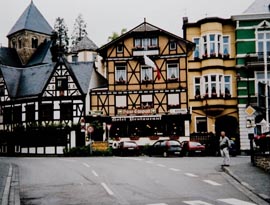
Our trips through this mountainous region of Germany took us to such places as Bad Neuenahr (a health spa), Ahrweiler, the beautiful, walled city of Bad Muenster-Eifel, Remagen and Koblenz on the Rhine. This whole area was much damaged during World War II and it was obvious that enormous restoration projects had taken place.
In Koblenz, our bus was parked near the "Deutsches Eck" (German Corner), so called because this is the place where the river Mosel (Moselle) joins the wide, fast-flowing Rhine. The "Deutsches Eck" is built in the form of a battle ship and is the site of the (re-erected), equestrian statue of Kaiser Wilhelm I. This place is a magnet for tourists.
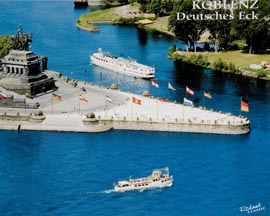
Remagen
One sunny day we left Altenahr on one of those fast German trains to do some sightseeing in Remagen, also on the Rhine. I talked with our bus driver (whom we met there) and told him and Corrie I needed to be alone in Remagen for a while. Having arrived there, I walked along the Rhine to the place where once a bridge spanned the river. During March 1945, this long bridge over the Rhine was captured in tact by the Americans, much to the chagrin of Hitler and the German generals. I just had to see this site.
Towards the end of WW II, the "Bridge of Remagen" was the center of events in world history, according to a pamphlet I picked up in the museum. The Allied troops had certainly not expected to find this bridge intact which would make it possible to cross the Rhine.
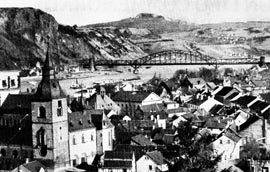
"Cross the Rhine with dry feet - courtesy of the 9th Army Division" read the sign posted on the bridge by the Americans. Eisenhower was quoted as saying: "...this bridge is worth its weight in gold." But Hitler was furious, suspecting sabotage, and ordered five of the responsible officers court-martialled and shot.
Ironically, a few days after its capture, the bridge simply collapsed after being heavily damaged by the relentless shelling of the German artillery. But by that time, the bridgehead had widened and the Americans were across the Rhine.
Today, the Rhine itself has long been cleared of the rubble. Many ships travel this section of the Rhine. But the blackened towers on both sides remain. In between those towers no bridge was ever built again. The towers on the Remagen town side is a museum and that is where I spent considerable time. A moment to remember!
Cochem and Monschau
One day was set aside for a possible river cruise on the Mosel river. We had coffee in Treis-Karden and then left for the quay where the cruise ship "Stadt Bonn" was waiting to take us to the town of Cochem where we would meet our bus again. Peace and silence descended upon us while the beautiful scenery glided by.
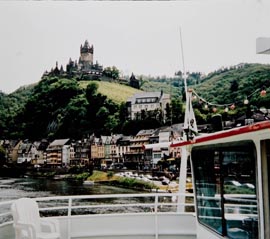
The view of Cochem getting nearer and nearer was a sight we will never forget. It was a picture to behold and once we were in town we looked in awe at the amazing architecture. And, yes, our faithful driver was waiting for us.
On the trip back to Beek's OAD Restaurant and Plaza we were in for more surprises. We passed the "Neuerburgring," the famous race track where Michael Schumacher became a star. It is also the place where Mercedes-Benz tests its new cars. Had the bus stopped we would have heard the roar of motor cars zooming around the track at well over 200 km/hr.
We stopped in Monschau, a picturesque town lying high in the hills, close to the Ardennes in Belgium. Malmedy, Belgium, is nearby. The "Battle of the Bulge" was fought not far from here. In Monschau, we boarded a tiny train which miraculously was able to climb the steep slopes and negotiate the very narrow streets in the village.
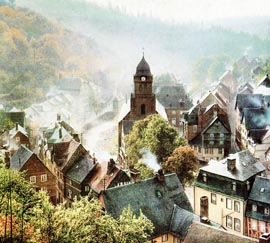
And then it was back to the familiarity and coziness of our native country, the Netherlands.
[an error occurred while processing this directive]